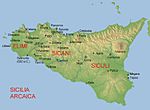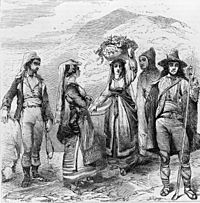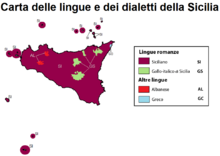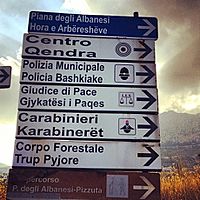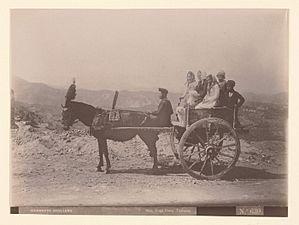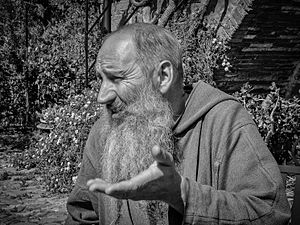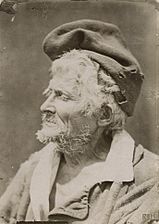Sicilians facts for kids
| Siciliani / Siculi (Italian) Siciliani (Sicilian) |
|
|---|---|
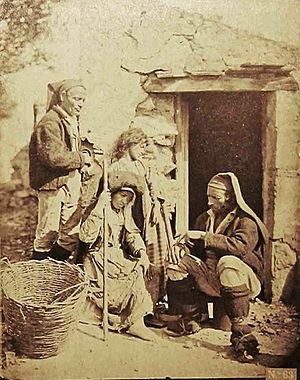
Sicilian peasants in traditional attire, 1880s
|
|
| Regions with significant populations | |
(inhabitants of Sicily) |
4,969,147 |
(of Sicilian ancestry) |
200,000 |
(of Sicilian ancestry) |
85,175 |
| Languages | |
| Sicilian • Gallo-Sicilian | |
| Religion | |
| Roman Catholic (Latin and Byzantine Rite) Minorities: Greek Orthodox |
|
| Related ethnic groups | |
| Italians, Greeks, Maltese | |
Sicilians are a group of people who come from the island of Sicily. Sicily is the largest island in the Mediterranean Sea and also the biggest and most populated of Italy's special regions. Sicilians speak a language called Sicilian, which is related to Italian.
Contents
Who are Sicilians?
The first people to live in Sicily arrived a very long time ago, during the Paleolithic and Neolithic periods. Many of these early people came from Southern Italy, but others traveled from the Islands of Greece, Western Asia, Spain, and Western Europe.
Ancient Tribes of Sicily
Before the Greeks and Romans, three main tribes lived in Sicily: the Elymians, the Sicanians, and the Sicels. The island was named after the Sicels, who were an Indo-European-speaking group. They likely moved to Sicily from the Italian mainland around 2000 BC.
The Elymians might have come from different places like Turkey, Calabria, or the Aegean Islands. They formed their own identity after settling in Sicily. The Sicanians were thought to be the oldest inhabitants. They might have traveled by boat from a river basin in Spain.
These tribes lived by both farming and fishing. Before farming began, Paleolithic Sicilians were hunter-gatherers, meaning they found their food by hunting animals and gathering plants. The Salsu river was a border between the Sicels and Sicanians.
They wore simple clothes made from wool, plant fibre, and animal skins. They made tools and weapons from metal, wood, and pottery. They lived in small family groups in simple huts made of mud, stones, or wood. They traveled on horseback, donkeys, or in chariots.
Archaeologists have found evidence of pet wildcats, dogs, and children's toys in ancient tombs. Their diet was similar to today's Mediterranean cuisine, including unique foods like Gaglioppo grapes and Diamante citron fruit.
These tribes were also skilled at building large stone tombs called dolmens. One important site is the Necropolis of Pantalica in Southeast Sicily. It has almost 4,000 rock-cut tombs from 1300 to 700 BC. This site is now a UNESCO World Heritage Site.
Ancient pottery from Sardinia has been found in Lipari, showing trade between islands. The Thapsos culture, linked to the Sicani, shows influences from ancient Greece. They built circular huts and traded bronze items with other cultures.
Another ancient culture was the Castelluccio culture, dating back to 2000 BC. They lived in villages in southeast Sicily and made pottery with special designs. They also mined flint for tools.
Ancient Beliefs and Gods
The early Sicilians worshiped many gods. The Sicels, Elymians, and Sicanians worshiped the Palici, twin gods linked to geysers and the underworld. They also worshiped Adranos, a volcano-fire god. People would go to a shrine of the Palici to swear oaths and be judged.
Mount Etna is named after the mythical Sicilian nymph Aetna. It was also believed to be where the giant Typhon and Enceladus were buried by Zeus. The Cyclopes, giant one-eyed creatures, were also linked to Sicily. They were said to help the Greek god Hephaestus at his forge under Mount Etna.
Besides Greek gods like Demeter and Persephone, Phoenician gods were also worshiped in Sicily. These included the bull god Moloch, the moon goddess Astarte, the goddess Tanit, and the weather and war god Baal. The Anapo river was seen as the god Anapos.
Early Settlements
The Elymians lived in western Sicily, the Sicanians in the central parts, and the Sicels in the eastern parts.
Ancient History and Roman Rule
Around the 11th century BC, people from Phoenicia started settling in western Sicily. Later, in the 8th century BC, Greeks began to colonize and settle heavily in Sicily, mostly in the eastern and southern parts. As the Greek and Phoenician towns grew, the Sicels and Sicanians moved further into the island's center.
The Phoenician settlements were later taken over by Carthage around 600 BC. By 300 BC, Syracuse was the biggest Greek city-state in the world. Sicily's politics were connected to those in Greece. For example, Athens launched a huge attack on Syracuse in 415-413 BC, which they lost badly.
Constant wars between Ancient Carthage and the Greek city-states opened the door for a new power: Rome. In the 3rd century BC, problems caused by mercenaries in Messina led Rome to get involved in Sicily. This started the First Punic War between Rome and Carthage. By 242 BC, most of Sicily was under Roman control, becoming Rome's first province outside Italy. Sicily remained a Roman province for the next 600 years.
Before Roman rule, there were native Elymian towns like Segesta and Eryx. Siculian towns included Enna and Pantalica, and the Sicanian town was Thapsos.
A king from Epirus named Pyrrhus ruled Sicily from 278 to 275 BC. He even captured the Elymian city of Eryx. But the Sicilian cities became hostile towards him, and he left the island. As he sailed away, he said, "What a wrestling ground we are leaving, my friends, for the Carthaginians and the Romans." This showed he knew Rome and Carthage would fight over Sicily.
The ancient historian Diodorus Siculus, who wrote a huge history of the world, and the brilliant scientist and mathematician Archimedes, who invented things like the Archimedes' screw, were both born and lived in Sicily.
Middle Ages and Different Rulers
As the Roman Empire weakened, a Germanic tribe called the Vandals took over Sicily for a short time starting in 440 AD. They controlled the Mediterranean grain trade. However, they soon lost Sicily to Odoacer in 476, and then to the Ostrogoths in 488. The Ostrogoths, led by Theodoric the Great, tried to bring back Roman culture.
Later, during the Gothic War (535–554), Sicily returned to Greco-Roman rule under the Byzantine Empire. Greek language and the Greek Orthodox religion became common. The Byzantine Emperor Constans II even wanted to move his capital to Syracuse in 663 AD, but he was assassinated. Sicily remained a peaceful Byzantine province for centuries.
The Byzantine province of Sicily also included Calabria in mainland Italy. Syracuse was its capital. The island was divided into districts.
In the 9th century, Arab Muslims invaded Sicily. This invasion was partly helped by a Byzantine-Sicilian commander named Euphemius, who invited the Arabs to help him rebel. The Muslim conquest was difficult, with strong resistance from the local people. The island was fully conquered by the Fatimid Caliphate in 965.
The new Arab rulers brought many changes. They improved farming with new methods and introduced crops like oranges, lemons, pistachio, and sugarcane. A merchant named Ibn Hawqal visited Palermo in 950 and described it as a large, busy city. By 1050, Palermo had a population of 350,000, making it one of Europe's biggest cities.
The local people conquered by the Muslims were mostly Greek-speaking Byzantine Christians, but there were also many Jews. Christians and Jews were allowed to practice their religions but had to pay special taxes. Many Jews moved to Sicily during Muslim rule.
In the 11th century, Norman mercenaries from northern Europe, who were Christian descendants of the Vikings, began to conquer Sicily. Led by Roger I, they took control of the entire island by 1091. In 1130, Roger II created the independent Kingdom of Sicily. This kingdom had its own Parliament, language, army, and money. Sicilian culture developed unique traditions and food. Many families from northern Italy, France, and England also settled in Sicily during this time.
The Norman rule lasted until 1198. Then, Frederick II, whose mother was a Norman queen and father a German emperor, became king. During his rule, the poetic form called a sonnet was invented in Sicily by Giacomo da Lentini. Frederick II also moved some Muslims to a new settlement in Italy.
After Frederick II, a French prince ruled Sicily for a short time. But the Sicilians rebelled in the War of the Sicilian Vespers, and the throne went to the daughter of Manfred of Sicily, Constance II, and her husband Peter III of Aragon. Their family ruled until 1401. After that, the Sicilian throne passed to Spanish monarchs.
Modern History and Italian Unification
In 1735, the Spanish era ended when Charles V became king. For about 150 years, Sicily was joined with the Kingdom of Naples in Southern Italy, ruled by the Bourbon dynasty from Naples.
After the Napoleonic Wars, King Ferdinand I combined the two kingdoms into the Kingdom of the Two Sicilies in 1816. However, in 1861, Sicily became part of the Kingdom of Italy during the Risorgimento. This was a movement that united all of Italy.
After Italy was unified and later the Fascist era, many Sicilians wanted more independence. This led to the Statute of Sicily, which made the island an autonomous region. Since 1946, Sicily has had a special status, giving it more control over its own affairs.
Sicilian Population
| Historical population | ||
|---|---|---|
| Year | Pop. | ±% |
| 1861 | 2,409,000 | — |
| 1871 | 2,590,000 | +7.5% |
| 1881 | 2,933,000 | +13.2% |
| 1901 | 3,568,000 | +21.7% |
| 1911 | 3,812,000 | +6.8% |
| 1921 | 4,223,000 | +10.8% |
| 1931 | 3,906,000 | −7.5% |
| 1936 | 4,000,000 | +2.4% |
| 1951 | 4,487,000 | +12.2% |
| 1961 | 4,721,000 | +5.2% |
| 1971 | 4,681,000 | −0.8% |
| 1981 | 4,907,000 | +4.8% |
| 1991 | 4,966,000 | +1.2% |
| 2001 | 4,969,000 | +0.1% |
| 2011 | 5,002,904 | +0.7% |
| 2017 | 5,029,615 | +0.5% |
| Source: ISTAT 2017 | ||

Sicily has been home to many different cultures and groups throughout its long history. This includes the original tribes (Sicani, Siculi, Elymians), as well as Phoenicians, Greeks, Romans, and Jews in ancient times.
In the Middle Ages, Sicily was ruled by Germanic Vandals, Iranic Alans, Byzantines, Arabs, and Normans. Later, people from Aragon, Spain, and France also ruled the island. Albanians settled and formed communities that still exist today.
About five million people live in Sicily, making it the fourth most populated region in Italy. However, after Italy was unified, many Sicilians moved away to other parts of Italy and countries like the United States, Canada, and Australia. It's estimated that over six million people of Sicilian descent live around the world. The most famous group is the Sicilian Americans.
Compared to other parts of Italy, not many immigrants come to Sicily. Most workers go to Northern Italy for better job opportunities. Recent numbers show about 175,000 immigrants in Sicily, which is about 3.5% of the population. Most of these immigrants are from Romania, Tunisia, Morocco, Sri Lanka, and Albania.
The main religion in Sicily is Roman Catholicism. The official language is Italian, but Sicilian is also widely spoken, though it is not officially recognized.
Major Cities
Sicily has three main metropolitan areas:
- Palermo, with over 1 million people in its wider urban area.
- Catania, with about 800,000 people in its wider urban area.
- Messina, with about 418,000 people in its wider urban area.
There are also fifteen cities and towns with populations over 50,000:
- Palermo (677,854)
- Catania (315,576)
- Messina (242,121)
- Syracuse (123,248)
- Marsala (82,812)
- Gela (77,295)
- Ragusa (73,756)
- Trapani (70,642)
- Vittoria (63,393)
- Caltanissetta (60,221)
- Agrigento (59,190)
- Bagheria (56,421)
- Modica (55,294)
- Acireale (53,205)
- Mazara del Vallo (51,413).
Common Names and Surnames
The most common first names in Sicily are Giuseppe, Maria, and Salvatore. The most common last names are Russo, Messina, and Lombardo.
| Most common names and surnames | |||
|---|---|---|---|
| 1 | Giuseppe | Russo | |
| 2 | Maria | Messina | |
| 3 | Salvatore | Lombardo | |
| 4 | Francesco | Caruso | |
| 5 | Giovanni | Marino | |
| 6 | Vincenzo | Rizzo | |
| 7 | Giuseppa | Grasso | |
| 8 | Carmelo | Greco | |
| 9 | Rosa | Romano | |
| 10 | Concetta | Parisi | |
| 11 | Carmela | Amato | |
| 12 | Anna | Puglisi | |
| 13 | Angelo | La Rosa | |
| 14 | Pietro | Costa | |
| 15 | Antonio | Vitale | |
| 16 | Francesca | Arena | |
| 17 | Angela | Pappalardo | |
| 18 | Rosario | Bruno | |
| 19 | Gaetano | Catalano | |
| 20 | Giovanna | Randazzo | |
Sicilians Around the World
In 2008, over 1 million Sicilians lived outside Sicily. Many live in the United States, Germany, Belgium, Switzerland, Argentina, Brazil, France, and Canada. The largest group of Sicilians outside Italy is the Sicilian Americans.
Sicilian Genetics
Studies of DNA show that people from Sicily are genetically very similar to people from Southern Italy, especially Calabria. They are also similar to people from Malta and Greek-speaking groups from the Ionian Islands, Aegean Islands, Crete, and the Peloponnese.
The Norman Kingdom of Sicily was created in 1130. Today, in northwest Sicily, around Trapani, Palermo, and Agrigento, Norman DNA is more common. It's estimated that ancient Greek DNA makes up about 37% of the paternal genetic legacy in Sicily, and Arab DNA is between 2% and 6%.
| Frequencies (in %) of haplogroups. | ||
|---|---|---|
| Y-chromosome | mtDNA | |
| 3.5% I1 | 5% HV | |
| 3.5% I2 | 45.2% H | |
| 4.5% R1a | 2.3% HV0+V | |
| 30.5% R1b | 6.7% J | |
| 9% G | 7.1% T | |
| 23% J2 | 10% U* | |
| 3% J* + J1 | 6.3% K | |
| 18% E1b1b | 6% N1+I | |
| 4% T | 1% N2+W | |
| 0% L | 3.7% X | |
| 1% Q | 6.7% Other | |
Sicilian Culture
Languages of Sicily

Most people in Sicily today speak both Italian and Sicilian. Sicilian is a unique Romance language with words from Greek, Norman, Arabic, Catalan, and Spanish. Other dialects similar to Sicilian are spoken in southern Calabria and Salento.
Sicilian was important in the early development of standard Italian. It was the official language of the Kingdom of Sicily from 1300 to 1543. Before the 20th century, many Sicilians spoke only Sicilian. Today, Italian is the official language, but Sicilian is still used daily.
The Siculo-Arabic dialect was a type of Arabic spoken in Sicily and Malta from the 9th to the 13th century. It died out in Sicily but developed into the Maltese language in Malta.
Siculish is a mix of Sicilian and English words used by Sicilian immigrants in the United States, Canada, and Australia. It shows how the Sicilian language adapted to English-speaking countries.
Minority Languages
There are two main historical language groups in Sicily: the Lombards of Sicily and the Arbëreshë.
- The Lombards of Sicily speak a unique group of dialects called Gallo-Italic of Sicily. These dialects came from people who migrated from Northern Italy about 900 years ago, during the Norman conquest. They settled in central and eastern Sicily.
- The Arbëreshë people are descendants of Albanian refugees who came to Southern Italy from the 15th to 18th centuries. They speak their own version of the Arbëresh language. Three communities in the province of Palermo have kept their Albanian language and culture: Contessa Entellina, Piana degli Albanesi, and Santa Cristina Gela.
- The Greeks of Messina speak modern Greek with some ancient Greek elements. Their community was re-established in 2003.
Religion in Sicily
Sicily has a history of many religions, including Islam, native beliefs, Judaism, and Paganism. This mix of religions has been seen as a good example of multiculturalism. Most Sicilians today are Catholic. Catholicism was brought to Sicily by Norman and Spanish rulers, who encouraged or forced people to convert.
Despite this, other religious communities exist in Sicily.
Sicilian Catholics For Catholics in Sicily, the Virgin Hodegetria is the patroness of Sicily. Sicilians also deeply respect female saints like Agatha (patron saint of Catania), Lucy (patron saint of Syracuse), and Saint Rosalia (patroness of Palermo).
Sicilians have played a role in religious history. Four Popes were Sicilian, and one Ecumenical Patriarch of Constantinople was also from Sicily. The New Testament mentions that Saint Paul visited Sicily for three days, becoming the first Christian to set foot on the island.
Sicilian Muslims During the period of Muslim rule, many Sicilians converted to Islam. Important Islamic scholars were born there. However, under Frederick II, all Muslims were expelled from the island. Any remaining Muslims were later expelled by the Spanish Inquisition.
In recent years, immigrants from Muslim countries like Pakistan, Albania, and Morocco have arrived in Sicily. In 1980, Catania opened Italy's first modern mosque, financed by Libya.
Sicilian Jewish Community It is believed that Jews first came to Sicily as slaves after the fall of Jerusalem in 70 CE. Judaism was the first monotheistic religion on the island. The Jewish community stayed in Sicily until 1493, when Queen Isabella I of Castile and Ferdinand II of Aragon expelled them. In 1740, King Charles III of Spain invited Jews to return, but this effort was not very successful.
Today, the Sicilian Jewish community is small but active. In 2005, a Passover Seder was held in Palermo for the first time since the expulsion. Rabbi Stefano Di Mauro, a Sicilian American, opened a small synagogue in 2008.
Art and Food
Sicily has a rich history of art and architecture, including the beautiful Sicilian Baroque style. Sicilian food is also famous, with unique dishes that combine influences from all the cultures that have lived on the island.
Gallery
- Sicilian folk costumes and traditions
See also
- List of people from Sicily
- Sicilian Wars
- Normans of Sicily
- Griko people
- Maltese people
- Kingdom of Africa


